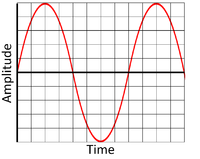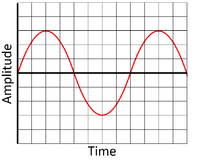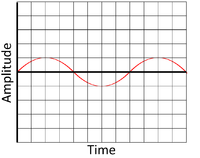Difference between revisions of "Amplitude"
| Line 9: | Line 9: | ||
*[[Sound]] - The louder the [[sound]]. | *[[Sound]] - The louder the [[sound]]. | ||
*[[Water Wave]] - The taller the [[wave]]. | *[[Water Wave]] - The taller the [[wave]]. | ||
| + | |||
| + | {| class="wikitable" | ||
| + | |- | ||
| + | |[[File:OscilloscopeScreen4.png|center|200px]] | ||
| + | |[[File:OscilloscopeScreen5.png|center|200px]] | ||
| + | |[[File:OscilloscopeScreen6.png|center|200px]] | ||
| + | |- | ||
| + | | style="height:20px; width:200px; text-align:center;" |This is a high [[amplitude]] [[wave]]. | ||
| + | | style="height:20px; width:200px; text-align:center;" | | ||
| + | | style="height:20px; width:200px; text-align:center;" |This is a low [[amplitude]] [[wave]]. | ||
| + | |} | ||
| + | |||
==Key Stage 4== | ==Key Stage 4== | ||
Revision as of 12:19, 18 February 2019
Contents
Key Stage 3
Meaning
The amplitude of a wave is the distance between the peak of a wave and the midpoint of the wave.
About Amplitude
The greater the amplitude of:
| This is a high amplitude wave. | This is a low amplitude wave. |
Key Stage 4
Meaning
The amplitude of a wave is the maximum displacement of the wave from its equilibrium position.
About Amplitude
The greater the amplitude of:


